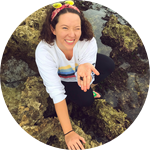Project Results
I observed the overall increase of density with time. This may be due to the exposures happening within the same seagrass patch. Since the entirety of a patch is a single plant if one area of the patch is exposed to NH4Cl it is possible the plant consolidated this newfound nutrients throughout the whole plant. If I was to repeat this experiment I would conduct it in a lab where there are less variables and the seagrass samples would be separate during exposure.
About This Project
Halophila hawaiiana is a Native Hawaiian seagrass that creates a habitat relied on by many organisms. H. hawaiiana is labeled as vulnerable to stressors likely due to development, invasive species, and pollution. Low leaf density of seagrass in Maunalua Bay compared to other populations of seagrass on Oahu has been observed this is possibly due to marine pollution. This study will measure the effects of ammonium exposure, simulating marine pollution, on H. hawaiiana.
Ask the Scientists
Join The DiscussionWhat is the context of this research?
H. hawaiiana on Paikō reef flat in Maunalua Bay is facing environmental stressors inhibiting the seagrass coverage. Paikō in the early 2000s had an invasive algae infestation that reduced seagrass by causing overcrowding and sedimentation of the water column inhibiting the amount of sun able to reach seagrass to keep it alive. Due to the efforts of Malama Maunalua, the water column has cleared up, but the seagrass population has yet to recover from this. In 2018 the state water quality assessment found indications of wastewater leakage. The major stressors of H. hawaiiana have decreased but pollution could be the reason it has struggled to return.
What is the significance of this project?
Understanding native ecosystem builders like H. hawaiiana is important and helps us understand what we need to do to protect these rare ecosystems. Considering all the stressors that this seagrass population in Maunalua Bay has been exposed to, having an ongoing assessment is necessary. This project will observe the current seagrass population over ten months. Studies on native organisms, specifically vulnerable species, can save populations, and studying H. hawaiiana maintains the relevance of the organism in the scientific community.
What are the goals of the project?
My goal for this project is to give a voice to Native Hawaiian seagrass ecosystems. By studying the negative effects ammonia exposure has on H. hawaiiana and making the research results public there is a possibility of policy in the future that can protect this ecosystem. I have studied the health and size of seagrass patches in Maunalua Bay by observing the photosynthetic ability, growth rate, and epifaunal coverage. The funding I am requesting will pay for granulate ammonia to expose isolated seagrass beds to simulate marine pollution, testing the water before and after exposure for ammonia levels, phosphorus levels, total dissolved nitrogen, and carbon. After exposure, I will re-measure the data to gauge the reaction of the seagrass.
Budget
The funding will help me complete my research project. The water samples in particular are the last piece of the project I need. I will be testing 3 times over one week: sites exposed to ammonium, negative control, positive control, and a site without seagrass. Then replicating the process.
Endorsed by
 Project Timeline
Project Timeline
I have already taken the baseline data of the area so all that is left is to expose the seagrass to the nitrogen and observe the reaction. This will likely take two weeks of fieldwork, the entirety of the project will be completed by May 9th.
Feb 12, 2022
Project Launched
Mar 06, 2022
Starting exposure to ammonium
Mar 13, 2022
Ending exposure to ammonium
Mar 27, 2022
Last day of fieldwork
Apr 15, 2022
Data analysis finished
Meet the Team
Affiliates
Megan Johnson
Ever since I was a kid I have always been interested in marine life. It wasn't until recently that I knew I wanted to work in conservation protecting marine life. One of the inspirational moments that helped me decide my future career was this research project on seagrass. Giving a voice to marine life to protect it from pollution and development is what we need. My goal with this project is to do exactly that for our Native Hawaiian seagrass ecosystems. By studying the negative effects of nitrogen exposure and making the research results public there is a possibility of policy in the future that can protect this ecosystem.
Project Backers
- 14Backers
- 100%Funded
- $3,440Total Donations
- $245.71Average Donation


